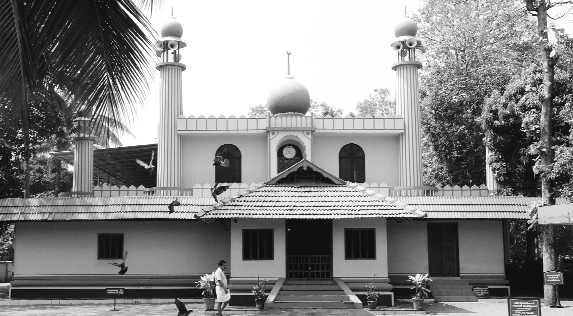
The Cheraman Juma Masjid is the first mosque built in the Indian subcontinent.
Vandana Shukla in Thrissur
In the narrow, scenic surroundings of Kodungallur, you tend to gloss over the generosity of the town’s founders and its believers — across centuries — as you get down at a bus stop. A curious glance informs you of road signs; one of them declares in bold letters: Cheraman Juma Masjid — the first mosque built in the Indian subcontinent, and probably, one of the oldest shrines in the world.
The Masjid appears like many other places of worship in God’s Own Country. One of the most striking features is its diminutiveness in its greatness, in its universal appeal. It was built in 629 AD (a plaque in Arabic declares the 5th year of Hizri) in the Malabar region, the region of the legendary Muziris port of the historic spice route that vanished around 3,000 years ago.
The kings of Kerala, mostly Hindus and Buddhists, not only allowed people of diverse faiths to settle down on their land, they also empowered them with special privileges: there are edicts issued by the kings to the Jews, Dutch Christians and Islamic trading communities of their times in the region. According to a legend popular among Keralites, Cheraman Perumal the Hindu Chera king visited Arabia, where he met Prophet Mohammed and was so impressed with his teachings that he embraced Islam. Prophet Mohammed gave him a new name Thajuddin. The legend goes on, saying the King wrote to his kingdom to embrace Islam and follow the teachings of Malik Bin Deenar, the Arab merchant credited with constructing the Cheraman Juma Masjid.
Historians refute this claim, though the tale of disappearance of the king is said to be true. Researchers point to 63 Shiva saints (Nayanmars), Cheraman Perumal included. Researchers say the Prophet lived from 570 to 631 Common Era (CE) while Perumal lived in the later part of the 7th century and the early part of 8th century. The legend of Perumal’s conversion is supported by the caretaker of the museum attached to Cheraman Masjid. “A mazar of Perumal Thajuddin exists at Salalah, Oman,” he says showing pictorial evidence.
Irrespective of myth-versus-history, the culture of the land is preserved by the mosque in times when religion-based identity assertion has become the norm. The ceremony of vidyarambham (initiation into the world of letters) is held inside the mosque even by the Hindus, the Imam of the mosque helps them write the first letter in the mother tongue, mostly Malayalam, on a slate. Several women wearing mangalsutra can be seen among hijab wearing women. But women are not allowed inside the mosque. The mosque keepers claim to possess a 1,000-year-old lamp to which the devotees of all faiths offer oil to keep it aflame. A few years back, the mosque management added a basement to accommodate a growing number of namazis.



























